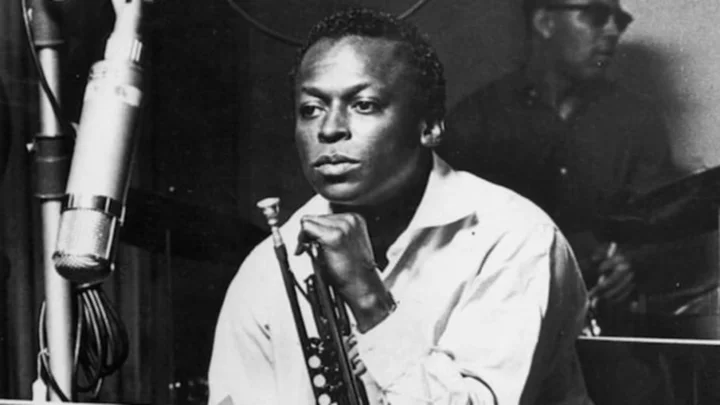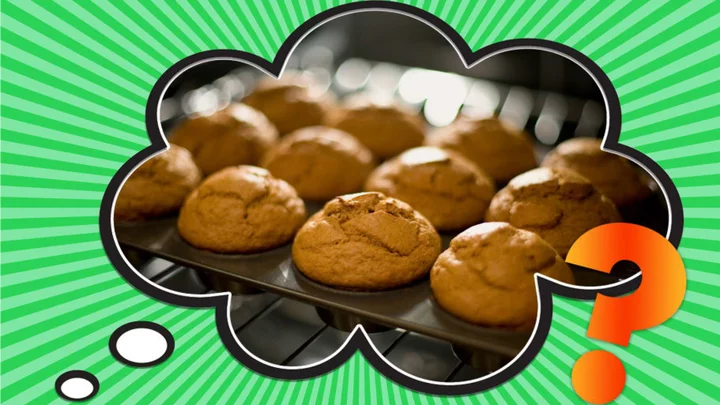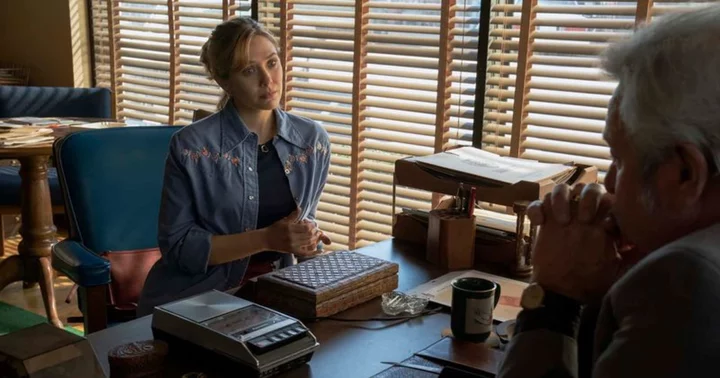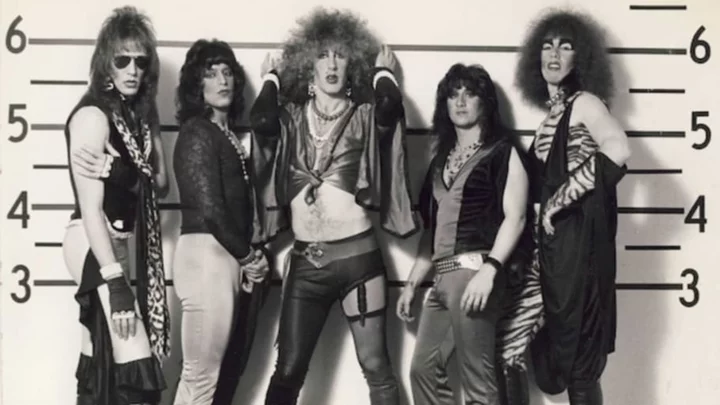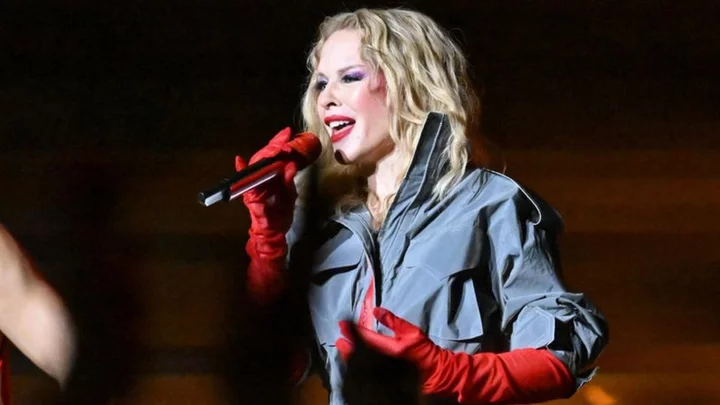Jazz trumpeter and composer Miles Dewey Davis III was not what you would call a humble man. At the very least, the multi-talented musician made it a little bit easier to describe his career when he himself said that he "changed music five or six times." Davis was inducted into the Rock and Roll Hall of Fame in 2006, 15 years after his passing, for being "one of the key figures in the history of jazz." It was an understatement, since Davis was responsible for popularizing the cool, modal, and fusion forms of jazz, and has influenced musicians in every genre; Davis collaborated with Jimi Hendrix and Prince. Had Hendrix not died, Davis and the guitar legend would have recorded together. Here are some facts about Miles Davis, who was born on May 26, 1926.
1. HE WAS FIRST TAUGHT THE TRUMPET, TO HIS MOTHER'S DISAPPROVAL.
Elwood Buchanan was one of Miles Davis's father's dental patients—and drinking buddies—and became Davis's trumpet teacher. On Davis' 13th birthday, his father bought him a new trumpet. His mother, Cleota, wanted him to have a violin; it caused a great argument between the couple but, as Davis wrote, "she soon got over it." In high school, Davis began studying with a German trumpeter named Gustav who played first trumpet with the St. Louis Symphony Orchestra. Buchanan was still Davis' high school music teacher, and one day in a formative moment of Miles' life, Buchanan stopped the band to admonish young Davis on his use of vibrato, saying he had "enough talent" to use a style all his own.
2. HE PLAYED WITH CHARLIE PARKER, WHO WAS ALSO HIS ROOMMATE.
When the Billy Eckstine band visited St. Louis in 1944, Dizzy Gillespie and Parker were members, and they invited Davis to replace Buddy Anderson as third trumpet (Anderson came down with tuberculosis, went back home to Oklahoma, and became a jazz pianist). After the experience, Davis was determined to move to New York City and get in touch with Parker again. After spending his first month's allowance in one week in New York, Davis went on his search. Despite saxophonist Coleman Hawkins' warnings to steer clear of Parker because of his heroin problem, Davis and "Bird" were roommates for a year.
3. HE ATTENDED JUILLIARD.
"Up at Juilliard," Davis said, "I played in the symphony, two notes, 'bop-bop,' every 90 bars, so I said, 'Let me out of here,' and then I left." In his autobiography, he recalled that along with just being bored with school—Davis was, after all, by this time playing in jazz clubs and with the likes of Charlie Parker every night—he found Juilliard to be "white-oriented" and "racist." One example was when a white female teacher told his class the reason black people played the blues was because they were poor and had to pick cotton. Davis wrote that he raised his hand, stood up, and said, "I'm from East St. Louis and my father is rich, he's a dentist, and I play the blues. My father didn’t never pick no cotton and I didn’t wake up this morning sad and start playing the blues. There's more to it than that." The teacher said nothing more on the subject.
4. HE TURNED DOWN WORKING WITH DUKE ELLINGTON IN ORDER TO FINISH BIRTH OF THE COOL.
Davis credited composer/pianist/bandleader Ellington as the root source for his landmark 1957 album Birth of the Cool, which made it all the more interesting when Davis had to turn him down.
Ellington—whom Davis had never met—sent for the young musician. Hearing that Ellington liked his style was a big deal to the young musician; Davis wrote that it "sent my ego climbing to the sky." When Davis went to meet his hero, Ellington was dressed in shorts with a woman sitting on his lap. Ellington invited him to join his band that fall, but Davis turned him down because he was working on Birth of the Cool. While his excuse was genuine, Davis also didn't want to play the same music night after night, which is something he feared would happen if he accepted Ellington's offer. He never spoke to Ellington again and sometimes wondered what would have happened if he had said "yes."
5. HE KICKED HEROIN COLD TURKEY.
In 1949, Davis became addicted to heroin. He would often say that it was because “I got bored and was around cats that were hung,” but in his autobiography he says that it was because of his depression at the time. He managed to quit in 1954, after growing sick and tired of it. "You know you can get tired of anything," Davis told Rolling Stone in 1969. "You can even get tired of being scared. I laid down and stared at the ceiling for 12 days, and I cursed everybody I didn't like. I was kicking it the hard way. It was like having a bad case of flu, only worse. I threw up everything I tried to eat. My pores opened up and I smelled like chicken soup. Then it was over."
6. HIS VOICE BECAME PERMANENTLY RASPY AFTER NOT FOLLOWING HIS DOCTOR'S ORDERS.
Davis had a throat operation in 1957 to remove nodes from his vocal cords. He was told not to raise his voice for 10 days. Two days after he was told this, he shouted at someone—either a record company owner or a booking agent—who, according to Davis, "tried to convince me to go into a deal I didn't want," permanently damaging his voice and giving it a rasp.
7. AMONG HIS PRE-SHOW RITUALS WERE AVOIDING FOOD (AND SEX).
He said that like fighters Joe Louis and Sugar Ray Robinson, he avoided shaking hands before performances (he supposedly didn’t want the oil from other people’s hands to mess up how his hands felt). Also like a boxer, he tied his shoelaces as tightly as possible, on shoes that were one size too small. Davis also declined food and sex before playing, purposely making himself hungry and unsatisfied.
8. HE HAD ISSUES WITH THELONIOUS MONK.
As Charles Mingus revealed in "An Open Letter to Miles Davis," printed November 30, 1955 in Down Beat magazine, Davis kept railing on Monk to "lay out" during a gig because he got the chords wrong. Later, during a recording session, he "cursed, laid out, argued, and threatened" the pianist/composer, and asked producer Bob Weinstock why he hired Monk, a "non-musician," in the first place.
9. HE DISAPPEARED FOR YEARS.
Davis stopped performing in the spring of 1976, and disappeared from the public eye. He hid away in his Manhattan brownstone until 1981. Fans of his hung out on his New York City block and went through his garbage. Rumors of a series of operations led people to believe he was dying. It turned out that beginning in 1975 he had an artificial hip implant, more throat polyp surgery, a painful leg infection, gallbladder issues, a bleeding ulcer, pneumonia, and chronic insomnia, and was too drugged up to perform.
10. HE HAD A LONG TALK WITH A YOUNG PHILIP SEYMOUR HOFFMAN.
When he was in his early 20s, the late Oscar-winning actor Philip Seymour Hoffman worked was a lifeguard at New York City's Metropolitan Towers, where Davis lived. One day, Davis came to the pool. "I didn't want to make him feel uncomfortable, so I pretended I didn't know him," Hoffman said. "He was wearing a Speedo with sunglasses and he had a towel and he got in the pool with his sunglasses and doggie-paddled about five laps, got out, took his sunglasses off and started talking to me because I don't think that he knew that I knew who he was." Davis then sat with Hoffman and talked for half an hour while looking at the city, talking about buildings he owned, accidents he got into, and girlfriends. "Everything except music," Hoffman said. "At the end of it he said, 'I'm Miles...' and he walked away."
This article was originally published on www.mentalfloss.com as 10 Kind of Blue Facts About Miles Davis.

